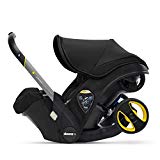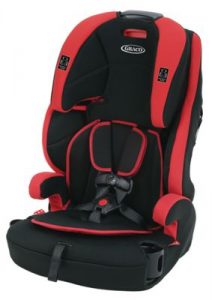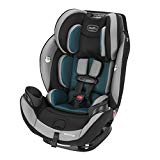
Car seat safety is complicated. From figuring out which one among the zillions to buy–to getting the installation right–it’s a lot to tackle. But in “Car Seats Made Easy,” Courtney Barry, Chicco’s Child Passenger Safety Advocate, simplified the process at the New York Baby Show in Manhattan.
In this What to Buy guide, BabyProductsMom shares her notes from Barry’s car seat safety seminar, which includes top car seat recommendations.
Barry’s expert advice and best practices can help you travel with your baby safely and with confidence.
(This post contains affiliate links for products BabyProductsMom would buy herself. Thanks for your support!)
Best Practice #1: When buying a car seat, think in stages.
Stage 1: Infant car seat (rear facing only)
“Most car crashes are frontal crashes,” Barry says. Riding rear facing helps disperse the energy from the crash force to protect your baby’s head, neck and spine. Use an infant car seat until your baby reaches the car seat’s weight or height limits, which varies per manufacturer (check your owner’s manual).

Courtney Barry, Chicco’s Child Passenger Safety Advocate
Infant car seat shopping tip: A level indicator on an infant car seat helps make sure your baby is sitting so his/her airway stays open when he/she is sitting in an infant car seat. Whether it’s a bubble level or a color indicator on the seat that turns green when the seat is safely angled, “every infant car seat manufacturer has a way to angle the seat,” Barry says.
When you’re infant car seat shopping, ask yourself and the salesperson (if there is one): What do I need to do to level the infant car seat? Master this maneuver.
Installation made easy:
Infant car seats come in two parts: the seat itself and the base. If you take lots of Ubers, Lyfts or taxis with your baby, read up on how install to the infant car seat without the base in the seat’s instruction manual.
Stage 2: Convertible car seat (rear and forward facing)
Next, use a convertible car seat in the rear facing mode until your baby maxes out in this mode, based on the seat’s size limits. You can use your vehicle’s seat belt or the Latch anchors to hold this seat in place. Then, turn the seat forward facing when it’s time, according to manufacturer’s size limits.
Installation made easy:
Use the Latch anchors or the seat belt to anchor the convertible car seat to the car, not both. If you use the Latch anchors, you’ll need to switch to securing the car seat with the seat belt when total weight of the car seat and your child reaches 65 pounds. (Just as an example: the Britax Boulevard convertible car seat with anti-rebound bar, weighs 29.4 pounds. By the way, it’s a BabyProductsMom fave. She often rents this car seat to grandparents and traveling parents as a BabyQuip Quality Provider, serving Connecticut and New York City.) That means you have 35.6 pounds of baby weight until you will need to switch the car seat base from Latch anchors to securing it to your car with the seat belt.)
Another installation tip: In rear-facing mode with an infant or convertible car seat, try to pinch the harness at your baby’s shoulder level. If you can pinch a fold, the harness is too loose, Barry says.
Stage 3: Harness booster (forward facing only)
From toddler to big kid, this seat offers a five point internal harness. Unlike a convertible car seat, it’s always used forward facing.
Stage 4: Belt-positioning booster
A glorified phone book, “this is the least used car seat, but it’s so important,” Barry says. A belt-positioning booster doesn’t offer an internal five-point harness. Rather, it uses your car’s seat belt to boost your child to the right height so the seat belt rests properly against your child’s torso to avoid injury from the seat belt in the event of a crash.
Your child can ditch the car seat when he/she reaches 4’9.”
Best Practice #2: Avoid these common car seat mistakes
Setting and forgetting. Parents who secure the car seat with the Latch anchors often forget to switch over to using a seat belt to secure the seat when car seat plus baby weight reaches 65 pounds.
If you think you might forget, you can skip using the Latch anchors if you want to, and just use the seat belt to secure your child’s convertible car seat, Barry says.
Jumping to the next-stage seat too soon, such as turning a convertible car seat to the forward-facing mode or moving from a car seat with a five-point harness to booster seat before your child has reached the maximum weight and height limits for the seat.
“Parents get excited about moving to the next car seat level, but they give up the added safety benefit,” Barry says.
The American Academy of Pediatrics recommends rear facing until your child reaches the maximum height or weight for that seat. Your state may specify until at least age 2. Consider: Convertible car seats have 40 to 50 pound upper weight limits. Depending on your child’s growth, “your child could be rear-facing until age 5,” Barry says.
Strapping your child in his/her infant car seat in her puffy snowsuit or winter coat. The harness won’t be tight enough to protect your child completely in the event of a crash. A safer bet: Harness your child into her car seat, then put her coat or a blanket over her when it’s chilly out.

Best Practice #3: Clean up your act
Dirty little secret: Your car seat will get trashed. From spilled bottles and sippy cups to mushy food pouches and melty ice cream, life is messy when you’re eating on the go. To clean your child’s car seat, read the instructions in your car seat owner’s manual. Don’t wing it. “Car seats are like a silk shirt. There are proper ways to clean them, including the harness,” Barry says.
Best Practice #4: Check out these car seat recommendations
Barry concluded the car seat safety seminar with these car seat recommendations.
Great infant car seats:
Chicco Fit2: This infant car seat rear facing up to 35 pounds and 35.” It’s designed to help your child stay rear facing comfortably longer. “Most kids will get to age 2 in the Fit2,” Barry says.

Doona infant car seat that converts to a stroller. “It’s great for city living,” Barry says. The premium car seat switches to a stroller in seconds. Rear facing only for infants 4 to 35 pounds and up to 32 inches.
Awesome options for toddlers:
Safe Rider Travel Vest. The Safe Rider Travel vest replaces a forward-facing car seat. “It’s a great option if you don’t want to lug around a car seat,” Barry says. For children age 3 and older.

Graco Wayz 3-in-1 harness booster: This harness booster seat is lightweight and easy to carry around. It’s starts at 2 years old and 20 pounds. (Available at GracoBaby.com.)
Consider getting a one and done:
Instead of buying a four car seats for every stage, you can just buy an all in one car seat, such as the Graco Extend2Fit convertible car seat. “All in one car seats reduce your carbon footprint and offer one stop shopping. Your baby will do a lot of things in this car seat,” Barry says. It’s four car seats in one.
An all in one car seat functions in rear-facing mode up to 50 pounds using the seat’s five-point harness; 22 to 65 pounds in forward facing mode, using the five point harness; 40 to 100 pounds in high back booster mode, using your vehicle’s seat belt, and 40 to 120 pounds as a backless booster seat.
The downside? You won’t have the cozy nest that an infant car seat offers, which allows you to easily transport your baby from the car to the house and beyond.
Other excellent all-in-one seats to consider:
Graco’s Milestone All-in-1 convertible car seat
Graco 4Ever 4 in 1 convertible car seat

Evenflo EveryStage LX All-in-One car seat
Safety 1st Grow and Go 3-in-1 convertible car seat
Overall, after you’ve purchased or registered for your car seat, installing the car seat can be, well–a project. To get it right, watch an installation video. If you’re still stuck, don’t be shy about asking for help by contacting your car seat’s customer service department. “Your best first resource is the manufacturer you buy your car seat from,” Barry says.
“We know the product best.”
If you’re still baffled, contact a car seat safety technician at the National Highway Traffic Safety Administration or SafeKids.org.
Expectant parents: Which baby products do you truly need? Which can you do without? Psst! This post can help you pick just the right products to help you feel prepared.
Product Wrap-up
Here’s a recap on the products highlighted in this car seat guide:
Infant car seats:
Great for toddlers and preschoolers:
- Safe Rider Travel Vest
- Graco Wayz 3-in-1 harness booster:
- Britax Boulevard convertible car seat with anti-rebound bar
All-in-one car seats (“one and done”):
- Graco Extend2Fit convertible car seat
- Graco’s Milestone All-in-1 convertible car seat
- Graco 4Ever 4 in 1 convertible car seat
- Evenflo EveryStage LX All-in-One car seat
- Safety 1st Grow and Go 3-in-1 convertible car seat










Leave a Reply